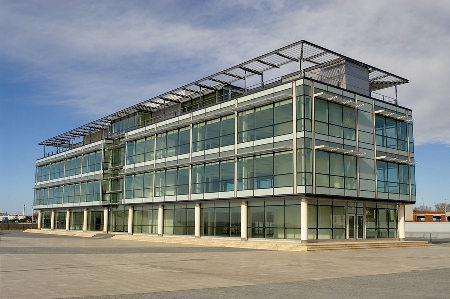In the big picture the percentage of gross domestic product (GDP) spent on non-residential construction has been in long term decline. The overall outlook in the forecasts involves a stabilisation of the share of GDP devoted to non-residential construction. The outlook for the sector differs very much by sub category of construction within the overall non-residential category and by different states. It is more important than ever to look at the details in the forecasts as well as the big picture.
ACIF Forecasts show that retail investment is defying the gloom – internet sales may be eating in to bricks 'n mortar retail and customers have been saving their money, but some retailers are taking the opportunity to refresh, renovate and expand their shops and service offering. In addition, wholesale and distribution investment continues.
For offices, the continued investment in Sydney's Barangaroo South is a dominant driver in the uptick in office investment. When this massive development comes on line there will be a series of other projects following, as existing stock is brought up to speed, but the category is not expected to grow as rapidly as it has in the past reflecting structural change and structural risks.
The big structural trend here is in the services sector. Australia is doing now what the rest of the world did in GFC Mark I, with a move to smaller space for office workers, and smaller leases. Large companies like ANZ are consolidating their needs. This risk seems to be a larger problem in some states than others.
Industrial construction shrank following the GFC and then recovered reflecting monetary policy settings and specific industry factors. The November 2013 forecasts for Australia at large project activity holding at the level achieved last year before resuming growth reflecting a return in investor confidence, increased competitiveness reflecting a moderation in the $A exchange rate and low interest rates. This is a category where the picture will be quite different for different states.
By state
New South Wales
Retail, health, and office investment are all expected to contribute to growth in this sector in the short term.
Victoria
A recovery is expected next year after several years of contractions. The upturn is not as large as previously foreshadowed. It will take some years for work done to claw its way back to levels achieved before the GFC. Declines in spending in areas such as Offices and Retail in the forecasts reflect the completion of current projects and increases in areas such as Industrial reflect a distribution of the expected national increase in investment in these areas given Victoria's traditional share of underlying economic activities.
Queensland
A bounce raising activity in 2013-14 and then contractions in later years, essentially holding a flat to negative outlook. The few bright spots include accommodation, entertainment and recreation, which are always volatile and variable. They are countered by contractions in areas such as health where the current major projects will be completed and not replaced and office construction, which is projected to shrink in the medium term (2-3 years).
South Australia
In contrast to general gloom about the retention of the automotive industry in South Australia the ACIF Forecasts project an swing into growth in Industrial construction in SA in the next few years. This reflects a continuation of work in the pipeline and then an increase in commercial activity reflecting relatively low interest rates. The projected increases should be viewed in context – they serve to bring construction work done up to the level regularly attained in the last decade rather than set new records.
Australian Capital Territory
Some growth in office and retail is forecast, essentially completing existing projects, but in real terms a contraction across the sector at best.
Western Australia
Investors seem to want to 'wait and see' about lower commodity prices and further mining construction. A reduction in non residential building activity is forecasts in the next few years.
Tasmania
Non-residential building activity obtains an up-lift in 2013- 14. This reflects some growth in general commerce reflecting a response to low interest rates, a moderation in the strength of the Australian Dollar that increases in tourism arrivals and retail turnover. Growth still leaves forecast activity well below levels achieved several years ago and there is a more than usual amount of forecast uncertainty around this recovery.
Northern Territory
Non-residential activity has been supporting the surge in Engineering construction and major energy investments in the Territory. Non-residential construction activity is forecast to fall away from the recent peak.
- Suppliers
- New to IndustrySearch? Book a Demo
- Advertise with us
- Login
- Email Marketing
- Buyers
- Get Quotes
- Articles & Ideas
- Login
- Subscribe to newsletter
- My Details
- Get Quotes
- Automation & Control
- Automotive Workshop Equipment
- Commercial Cleaning Equipment & Supplies
- Construction Equipment & Heavy Machinery
- Conveyor Systems & Components
- Electrical & Power Generation Equipment
- Electronic Components
- Farming & Agriculture
- Food & Beverage Processing
- Forklifts & Forklift Attachments
- Hydraulic & Pneumatic Equipment
- Industrial Materials, Tools & Components
- Industrial Pumps
- IT Hardware & Industrial Computing
- IT Software & Applications
- Laboratory Equipment & Instruments
- Manufacturing & Industrial Equipment
- Material Handling & Lifting Equipment
- Metalworking & Machining
- Mining Equipment & Machinery
- Packaging & Labelling Machinery
- Pallet Handling Equipment
- Personal Protective Equipment
- Security & Surveillance
- Test & Measurement
- Transport & Logistic Equipment
- Warehouse Storage, Shelving & Racking
- Waste Treatment & Environmental Management
- Welding Machines & Accessories
- Woodworking & Joinery Machines
- Workplace Equipment
- Workplace Safety Equipment
- Get Quotes
- Automation & Control
- Automotive Workshop Equipment
- Commercial Cleaning Equipment & Supplies
- Construction Equipment & Heavy Machinery
- Conveyor Systems & Components
- Electrical & Power Generation Equipment
- Electronic Components
- Farming & Agriculture
- Food & Beverage Processing
- Forklifts & Forklift Attachments
- Hydraulic & Pneumatic Equipment
- Industrial Materials, Tools & Components
- Industrial Pumps
- IT Hardware & Industrial Computing
- IT Software & Applications
- Laboratory Equipment & Instruments
- Manufacturing & Industrial Equipment
- Material Handling & Lifting Equipment
- Metalworking & Machining
- Mining Equipment & Machinery
- Packaging & Labelling Machinery
- Pallet Handling Equipment
- Personal Protective Equipment
- Security & Surveillance
- Test & Measurement
- Transport & Logistic Equipment
- Warehouse Storage, Shelving & Racking
- Waste Treatment & Environmental Management
- Welding Machines & Accessories
- Woodworking & Joinery Machines
- Workplace Equipment
- Workplace Safety Equipment
Trusted by 1,000,000+ Australian industrial buyers
Buyers
- Discover products & solutions
- Login
- Subscribe To Newsletter
- Browse All Products
- Read Articles
Suppliers
Advertise
- Promote your products & solutions
- New to IndustrySearch? Book a Demo
- Login / Forgot Password
- Advertise Your Products
- Success Stories
- Email Marketing
- Suppliers
- Advertise with us
- Login
- Email Marketing
- Buyers
- Get Quotes
- Articles & Ideas
- Login
- Subscribe to newsletter
- My Details
Get Quotes
- Automation & Control
- Automotive Workshop Equipment
- Commercial Cleaning Equipment & Supplies
- Construction Equipment & Heavy Machinery
- Conveyor Systems & Components
- Electrical & Power Generation Equipment
- Electronic Components
- Farming & Agriculture
- Food & Beverage Processing
- Forklifts & Forklift Attachments
- Hydraulic & Pneumatic Equipment
- Industrial Materials, Tools & Components
- Industrial Pumps
- IT Hardware & Industrial Computing
- IT Software & Applications
- Laboratory Equipment & Instruments
- Manufacturing & Industrial Equipment
- Material Handling & Lifting Equipment
- Metalworking & Machining
- Mining Equipment & Machinery
- Packaging & Labelling Machinery
- Pallet Handling Equipment
- Personal Protective Equipment
- Security & Surveillance
- Test & Measurement
- Transport & Logistic Equipment
- Warehouse Storage, Shelving & Racking
- Waste Treatment & Environmental Management
- Welding Machines & Accessories
- Woodworking & Joinery Machines
- Workplace Equipment
- Workplace Safety Equipment
Get Quotes
- Automation & Control
- Automotive Workshop Equipment
- Commercial Cleaning Equipment & Supplies
- Construction Equipment & Heavy Machinery
- Conveyor Systems & Components
- Electrical & Power Generation Equipment
- Electronic Components
- Farming & Agriculture
- Food & Beverage Processing
- Forklifts & Forklift Attachments
- Hydraulic & Pneumatic Equipment
- Industrial Materials, Tools & Components
- Industrial Pumps
- IT Hardware & Industrial Computing
- IT Software & Applications
- Laboratory Equipment & Instruments
- Manufacturing & Industrial Equipment
- Material Handling & Lifting Equipment
- Metalworking & Machining
- Mining Equipment & Machinery
- Packaging & Labelling Machinery
- Pallet Handling Equipment
- Personal Protective Equipment
- Security & Surveillance
- Test & Measurement
- Transport & Logistic Equipment
- Warehouse Storage, Shelving & Racking
- Waste Treatment & Environmental Management
- Welding Machines & Accessories
- Woodworking & Joinery Machines
- Workplace Equipment
- Workplace Safety Equipment
Trusted by 1,000,000+ Australian industrial buyers




